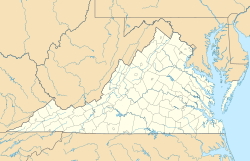History
In 1858, several Catholic families donated a tract of land to the Diocese of Richmond not far from the Fairfax Courthouse in hopes that a church and cemetery be built there. Several years later, many Irish immigrants were hired by the Orange & Alexandria (O&A) railroad to extend its tracks from Alexandria, Virginia, to Lynchburg, Virginia. These men and their families desired a place to worship. The only option at the time was for a priest to take the O&A train to the Fairfax Station depot, and he said Mass while in a boxcar. In 1855, the cemetery was consecrated in the donated land, which was up on a bluff overlooking the railroad depot. Construction of the church took two years. The church was consecrated by the Bishop of Richmond on September 23, 1860. During the Civil War, following the first battle of Bull Run in the summer of 1861, the routed Union soldiers retreated through Centerville and headed for Fairfax Station, seeking transportation to safety. Included were numerous wounded and injured men. All of the church pews were removed from the small church to make room for treatment of wounded and dying men. As these men were transported east, to Alexandria, on trains, volunteers boarded the now empty rail cars headed back to Fairfax Station to assist in providing medical care on the grounds of Saint Mary's. Clara Barton was among the number of volunteer nurses who responded to calls for treatment of the wounded and dying men. As the Confederate forces reached Fairfax Courthouse, they learned of the large number of Union casualties being treated at the depot and the church. As they approached the railroad depot, the last of the survivors were pulling out of the station. The Confederates promptly burned the church to the ground.
The small catholic church remained in full operation until the mid-1980s, when a new parish center was built about six miles north of the original church. Over time, fewer and fewer Masses were celebrated in the historic church, but it was popular for weddings. In 2020 a new, much larger church was built on property adjacent to the parish center The historic church remains an ideal site for weddings, and its original cemetery is still used for burials.
This page is based on this
Wikipedia article Text is available under the
CC BY-SA 4.0 license; additional terms may apply.
Images, videos and audio are available under their respective licenses.


